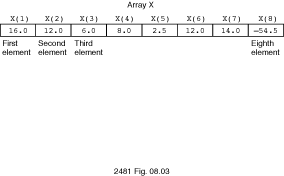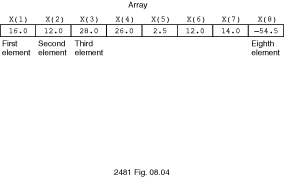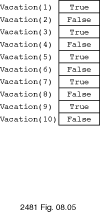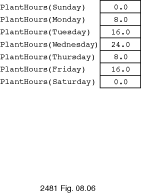
A record contains fields, each of which is potentially of a different type; such a composite type is often called heterogeneous. An array, on the other hand, contains elements all of which are of the same type; such a type is often called homogeneous. As with record types, we first declare an array type, which provides a template, or recipe, for creating arrays. Then we actually create an array--cause the compiler to allocate storage for it--with an array variable declaration.
FloatArray is declared below followed by the
declaration of array X of type FloatArray:
TYPE FloatArray IS ARRAY (1..8) OF Float;
X : FloatArray;
The
type declaration indicates our desire that each array be a collection of eight
memory cells. The variable declaration causes a specific collection of eight
cells to be associated with the name X; these memory cells are
usually adjacent to each other in memory. Each element of array X
can contain a single Float value, so a total of eight
Float values can be stored and referenced using the array name
X. (Note: The fact that an array's elements are in adjacent
memory cells is not required by Ada, but it enables the compiler to get to all
elements of an array just by knowing where the first element is stored.)
X is the array with eight elements declared above, we
refer to the elements of the array X as shown in Fig. 8.3.
Figure 8.3
The Eight Elements of the Array X

The subscripted variable X(1) (read as X sub
1) may be used to reference the first element of the array
X; X(2), the second element; and X(8),
the eighth element. The number enclosed in brackets is the array subscript. As
we will see later, the subscript does not have to be a constant.
Let X be the array shown in Fig. 8.3. Some
statements that manipulate
this array are shown in Table 8.1.
Table 8.1
Statements that Manipulate Array X
Statement Explanation Ada.Float_Text_IO.Put( X( 1)); Displays value of X( 1), or 16.0. X( 4) := 25.0; Stores value 25.0 in X( 4). Sum := X( 1) + X( 2); Stores sum of X( 1) and X( 2), or 28.0, in Sum. Sum := Sum + X( 3); Adds X( 3) to Sum. The new Sum is 34.0. X( 4) := X( 4) + 1.0; Adds 1.0 to X( 4). The new X( 4) is 26.0. X( 3) := X( 1) + X( 2); Stores sum of X( 1) and X( 2), or 28.0, in X( 3).
The contents of array X are shown in Fig. 8.4
after execution of these statements. Only X( 3) and
X( 4) are changed.
Figure 8.4
Array X After Modification

Some declarations for a manufacturing plant operations program is
shown below. The type declarations declare two scalar subtypes,
EmpRange and HoursRange, and an enumeration type,
Days, and two array types, EmpArray and
DayArray. Two array variables, Vacation and
PlantHours, are declared in the variable declaration section.
NumEmp : CONSTANT Positive := 10; -- Number of employees
SUBTYPE EmpRange IS Positive RANGE 1..NumEmp; -- subscript range
SUBTYPE HoursRange IS Float RANGE 0.0..24.0; -- hours in a day
TYPE Days IS
(Monday, Tuesday, Wednesday, Thursday, Friday, Saturday, Sunday);
TYPE EmpArray IS ARRAY(EmpRange) OF Boolean;
TYPE DayArray IS ARRAY(Days) OF NonNegFloat;
Vacation : EmpArray;
PlantHours : DayArray;
The array Figure 8.5Vacation has ten elements (subscripts
1 through NumEmp); each element of array
Vacation can store a Boolean value. The contents of
this array could indicate which employees were on vacation
(Vacation(i) is True if employee i is on
vacation). If employees 1, 3, 5,
7, and 9 were on vacation, the array would have the
values shown in Fig. 8.5.
Array Vacation

The array PlantHours has seven elements (subscripts
Monday through Sunday). The array element
PlantHours(Sunday) could indicate how many hours the plant was
operating during Sunday of the past week. The array shown in Fig.
8.6 indicates that the plant was closed on the weekend, operating single
shifts
on Monday and Thursday, double shifts on Tuesday and Friday, and a triple shift
on Wednesday.
Figure 8.6
Array PlantHours
SYNTAX DISPLAY
Array Type Declaration
TYPE array-type IS ARRAY
subscript-type OF element-type;
SUBTYPE WordWidth IS Positive RANGE 1..32; TYPE BitVector IS ARRAY ( WordWidth) OF Boolean;
2. A floating-point type cannot be a subscript-type because it is not discrete, as it represents a continuous range of values.
3. It is unwise to use as a subscript-type a predefined type with a
large range of values (e.g., Integer) because doing so would
result in arrays with a gigantic number of elements. Generally, our subscript
types will be either user-defined subtypes of Integer with fairly
small ranges or user-defined enumeration types.
It is important to realize that an array type declaration does not cause allocation of storage space in memory. The array type describes the structure of an array only. Only variables actually store information and require storage. Storage space is not allocated until a variable of this type is declared.
Two basic operations act on elements of an array: store and retrieve; also, as in records, assignment and equality test are available for array variables.
A is an array, C is an expression that is compatible
with the element type of A, and i is an expression
that is compatible with the subscript type, the statement
A(i) := C;
stores the contents of C in element
i of array A.
C is a variable that is assignment
compatible with the element type of A, the statement
C := A(i);
retrieves element i of array A and
copies its value into C. For both of these statements the value of
subscript i must be in the range of the array subscript type;
otherwise, Constraint_Error will be raised.
A and B are compatible arrays, the
statement
A := B;
copies all values associated with array B to
array A.
A and B are compatible arrays, the
Boolean expression
A = B;
evaluates to True if and only if each element of
A is equal to the corresponding element of B, and the
Boolean expression
A /= B;
evaluates to True if and only if any elements of
A are not equal to the corresponding elements of B.
The discussion above summarizes all the information that we need to know to use an array. We do not need to know how Ada stores the elements of an array in memory or how it implements the retrieve and store operators above.
As in the case of records, an entire array can be filled with values by three methods:
It is the last method that concerns us now. Given an array A of
type TestArray, the 100 Float values could, if they
were all known in advance, be stored in A with a single statement
such as
A := ( 1.0, 27.0, 35.0, -4.0, 15.0, ...);
where the ellipsis must be replaced completely with the other
95 values. This is surely tedious, but it is better than writing 100 separate
assignment statements. As in the case of records, named association can also be
used:
A := ( 1 => 1.0, 2 => 27.0, ...);
where the remaining 95 values also need to be supplied. Whereas
in record aggregates we prefer named association, in array aggregates it can be
cumbersome because an array can have a large number of elements. In using array
aggregates we will generally use positional association unless there is a good
reason not to do so.
A common and useful application of array aggregates is to initialize most or
all elements of an array with the same value. Suppose that our array
A were to be "cleared" so that all values were 0. This could be
done in a loop:
FOR I IN 1..MaxSize LOOP
A( I) := 0.0;
END LOOP;
or with a single aggregate assignment:
A := ( 1..MaxSize => 0.0);
The aggregate assignment is certainly more concise, expresses
the will of the programmer clearly, and may possibly execute faster. Suppose
now that A were to be initialized such that its first 5 elements
were as above, but the other 95 were to be 0. The assignment
A := ( 1.0, 27.0, 35.0, -4.0, 15.0, OTHERS => 0.0);
does the trick. The OTHERS clause informs the
compiler to store 0s in all those elements not expressly listed in the
aggregate. If, say, only the first, third, and fifth elements were nonzero,
named association could be used:
A := ( 1 => 1.0, 3 => 27.0, 5 => 35.0, OTHERS => 0.0);
Finally, the assignment
A := ( OTHERS => 0.0);
fills the entire array with 0s even more concisely: Because no
other elements were explicitly filled, the OTHERS applies to all
elements.
It is important to remember in using an aggregate that all elements
of the array must be initialized by the aggregate; otherwise a compilation
error results. OTHERS initializes all elements not otherwise
given.
X3 and
X( 3)?
TYPE AnArray IS ARRAY( 1..5) OF Character; Grades : AnArray;When is the memory allocated--after the type declaration or after the variable declaration?
a. Subscript type Boolean, element type Float
b. Subscript type 'A'..'F', element type Integer
c. Subscript type Character, element type Boolean
d. Subscript type Integer, element type Float
e. Subscript type Character, element type Float
f. Subscript type Float, element type Character
g. Subscript type Day (enumeration type), element type
Float
A: ARRAY(1..5) OF Integer; B: ARRAY(1..5) OF Integer; C, D: ARRAY(1..5) OF Integer; TYPE List IS ARRAY (1..5) OF Integer; E: List; F: List; G, H: List;Explain why each of the following statements is valid or invalid:
A := B; C := D; E := F; G := H;Check your results by writing and compiling a brief program incorporating these statements.
Copyright © 1996 by Addison-Wesley Publishing Company, Inc.